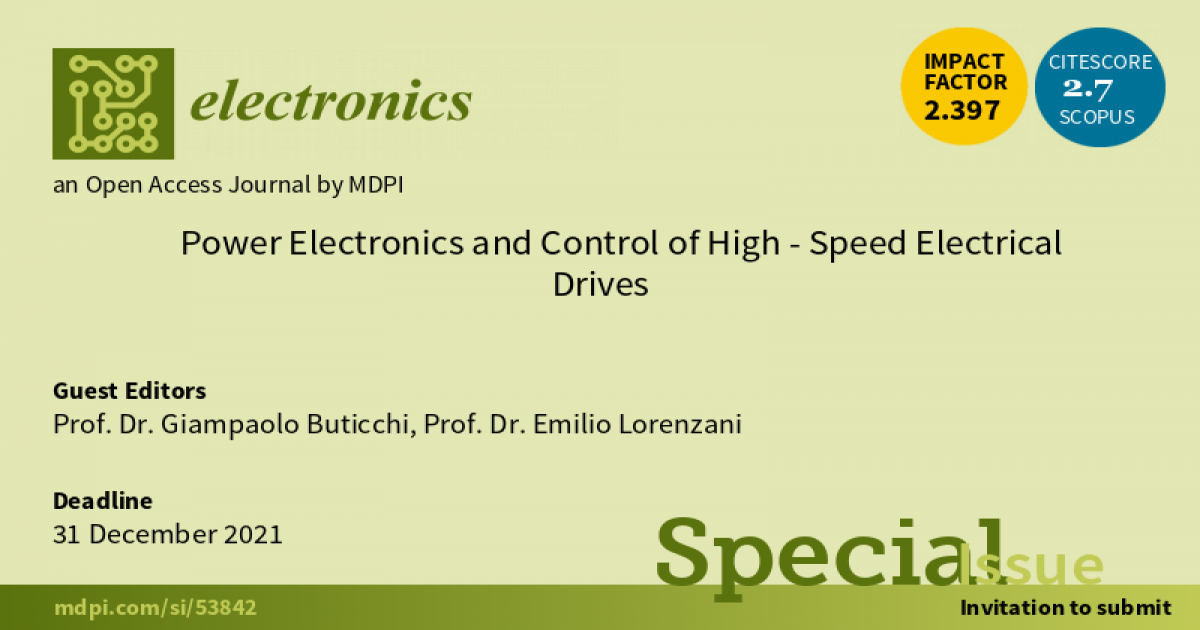Power Electronics and Control of High-Speed Electrical Drives
A special issue of Electronics (ISSN 2079-9292). This special issue belongs to the section "Power Electronics".
Deadline for manuscript submissions: closed (31 December 2021) | Viewed by 12838

Special Issue Editors
Interests: DC distribution systems and power electronics for the more electric aircraft; high performance electric drives
Special Issues, Collections and Topics in MDPI journals
Interests: power converters for renewable energies sources; high performance electric drives
Special Issues, Collections and Topics in MDPI journals
Special Issue Information
Dear Colleagues,
Interest in high-speed machines electrical drives has increased in recent years, together with the need to increase the speed of electrical machines characterized by a high number of pole pair thanks to the use of different flux-weakening techniques. We find applications of these drives in the distribution grid of the more electric aircraft, in high-speed actuators, in electric turbochargers for internal combustion engines, in direct-drive large generators for wind energy conversion systems, in high-performance electric drives for the industrial and robotics fields, and so on.
In all cases, there is the need to supply the electrical machine with a high fundamental frequency current, raising critical issues for power electronics and the inner current loops of the electrical drives. To obtain a good phase current control with low harmonics distortion, the switching frequency should be increased, or the architecture of the current loops should be modified to expand the bandwidth with limited switching frequency.
The goal is to minimize torque ripple and electrical machines’ power losses with the aid of suitable flux-weakening techniques, if needed and applicable to that kind of electrical machine.
In addition to specific controls, the aforementioned issues can be addressed with wide band-gap devices and/or multilevel topologies that allow decreasing the harmonic phase current distortion with suitable switching strategies for the command of power transistors.
Finally, studies can also focus on power converters solutions characterized by soft-switching commutations and/or a reduction of output common-mode voltage variations.
Prof. Dr. Giampaolo Buticchi
Prof. Dr. Emilio Lorenzani
Guest Editors
Manuscript Submission Information
Manuscripts should be submitted online at www.mdpi.com by registering and logging in to this website. Once you are registered, click here to go to the submission form. Manuscripts can be submitted until the deadline. All submissions that pass pre-check are peer-reviewed. Accepted papers will be published continuously in the journal (as soon as accepted) and will be listed together on the special issue website. Research articles, review articles as well as short communications are invited. For planned papers, a title and short abstract (about 250 words) can be sent to the Editorial Office for assessment.
Submitted manuscripts should not have been published previously, nor be under consideration for publication elsewhere (except conference proceedings papers). All manuscripts are thoroughly refereed through a single-blind peer-review process. A guide for authors and other relevant information for submission of manuscripts is available on the Instructions for Authors page. Electronics is an international peer-reviewed open access semimonthly journal published by MDPI.
Please visit the Instructions for Authors page before submitting a manuscript. The Article Processing Charge (APC) for publication in this open access journal is 2400 CHF (Swiss Francs). Submitted papers should be well formatted and use good English. Authors may use MDPI's English editing service prior to publication or during author revisions.
Keywords
- High-speed electrical drives
- Flux-weakening strategies
- Wide band-gap devices
- Power converter topologies
- Multilevel topologies
- Soft switching techniques
- Current control
- High pole pair machines
- Common-mode current
- Bearing current
Benefits of Publishing in a Special Issue
- Ease of navigation: Grouping papers by topic helps scholars navigate broad scope journals more efficiently.
- Greater discoverability: Special Issues support the reach and impact of scientific research. Articles in Special Issues are more discoverable and cited more frequently.
- Expansion of research network: Special Issues facilitate connections among authors, fostering scientific collaborations.
- External promotion: Articles in Special Issues are often promoted through the journal's social media, increasing their visibility.
- Reprint: MDPI Books provides the opportunity to republish successful Special Issues in book format, both online and in print.
Further information on MDPI's Special Issue policies can be found here.






